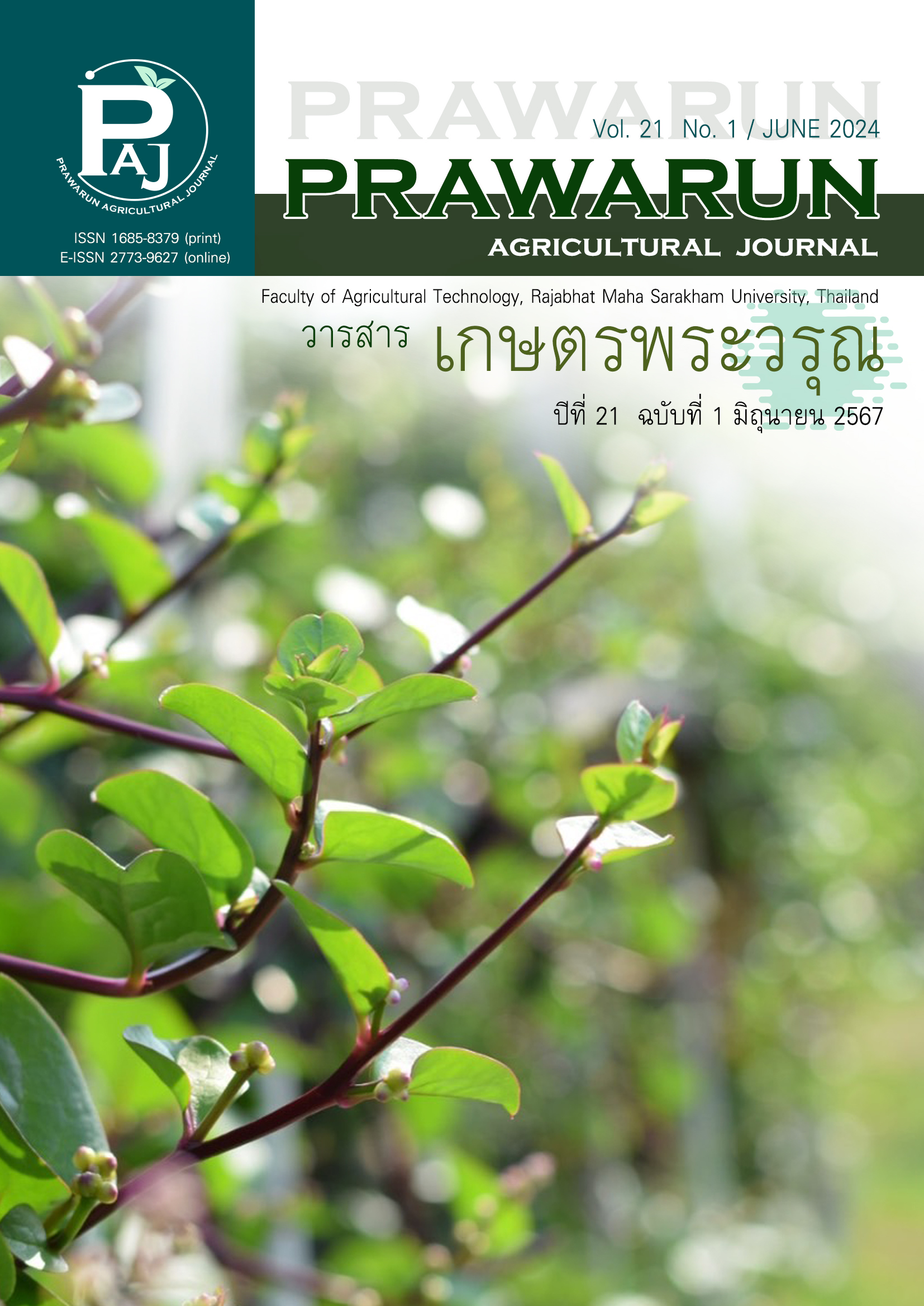ผลของการเสริมผงสกัดหยาบเบต้าแคโรทีนจากเปลือกมะม่วง ต่อสมรรถนะการเจริญเติบโตของไก่เนื้อ
Main Article Content
บทคัดย่อ
การศึกษาครั้งนี้มีวัตถุประสงค์เพื่อศึกษาผลของการเสริมผงสกัดหยาบเบต้าแคโรทีนจากเปลือกมะม่วงในอาหารต่อสมรรถนะการเจริญเติบโตของไก่เนื้อ ใช้ไก่เนื้อสายพันธุ์อาร์เบอร์ เอเคอร์ส อายุ 1 วัน จำนวน 200 ตัว สุ่มไก่ออกเป็น 5 กลุ่ม ตามปัจจัยที่ใช้ในการศึกษา (ระดับการเสริมผงสกัดหยาบเบต้าแคโรทีนจากเปลือกมะม่วงในอาหาร ร้อยละ 0.00 0.25 0.50 0.75 และ 1.00) ตามแผนการทดลองแบบสุ่มสมบูรณ์ ปัจจัยละ 4 ซ้ำ ซ้ำละ 10 ตัว ให้ไก่เนื้อได้รับอาหารและน้ำอย่างเต็มที่ จนกระทั่งอายุ 42 วัน ผลการศึกษาพบว่าไก่เนื้อที่ได้รับอาหารเสริมผงสกัดหยาบเบต้าแคโรทีนจากเปลือกมะม่วงร้อยละ 0.25 0.50 0.75 และ 1.00 มีอัตราการเจริญเติบโตสูงกว่าไก่เนื้อที่ได้รับอาหารไม่เสริมผงสกัดหยาบเบต้าแคโรทีนจากเปลือกมะม่วง มีค่าเป็น 62.40 62.72 63.17 62.51 และ 60.39 กรัมต่อตัวต่อวัน ตามลำดับ เช่นเดียวกับอัตราการเปลี่ยนอาหารเป็นน้ำหนักตัว (2.15 2.17 2.16 2.18 และ 2.22 ตามลำดับ) ประสิทธิภาพการใช้โปรตีน (2.25 2.23 2.24 2.22 และ 2.19 ตามลำดับ) และดัชนีประสิทธิภาพการผลิตเพิ่มขึ้น (283.17 282.44 284.73 281.79 และ 260.87 ตามลำดับ) แต่ไม่มีความแตกต่างกันทางสถิติ (p > 0.05) ผลการศึกษาชี้ให้เห็นว่าการเสริมผงสกัดหยาบเบต้าแคโรทีนจากเปลือกมะม่วงมีแนวโน้มทำให้สมรรถนะการเจริญเติบโตของไก่เนื้อดีขึ้น
Article Details
เอกสารอ้างอิง
Ajila, C. M., Bhat, S. G., & Prasada Rao, U. J. S. (2007). Valuable components of raw and ripe peels from two Indian mango varieties. Food Chemistry, 102(4), 1006-1011. doi: 10.1016/j.foodchem.2006.06.036
Arbos, K., Stevani, P. C., & de Fátima Castanha R. (2013). Antimicrobial and antioxidant activity and total phenolic content in mango peel and kernel. Revista Ceres, 60(2), 161-165. doi:10.1590/S0034-737X2013000200003
Bhasharachary, K., Sankar Rao, D. S., Deosthale, Y. G., & Redely, V. (1995). Carotene content of some common and less familiar foods of plant origin. Food Chemistry, 54(2), 189-193. doi: 10.1016/0308-8146(95)00029-I
Buanong, M., & Kanlayanarat, S. (2010). Role of methyl jasmonate on changes in carotenoid and beta-carotene contents of mango fruits (Mangifera indica Linn.) “Nam Dok Mai” after harvest. Postharvest Technology Innovation Center, 9(4), 1-3.
Diarra, S. S., Usman, B. A., & Igwebulke, J. U. (2010). Replacement value of boiled mango kernel meal for maize in broiler finisher diets. ARPN Journal of Agricultural and Biological Science, 5(1), 47-52.
Diarra, S. S., Saleh, B., Kwari, I. D., & Igwebuike, J. U. (2011). Evaluation of boiled mango kernel meal as energy source by broiler chickens in the semi-arid zone of Nigeria. International Journal of Science and Nature, 2(2), 270-274.
Emshaw, Y., Melesse, A., & Assefa, G. (2012). The effect of dietary inclusion of mango fruit (Magnifera indica L.) waste on feed intake, growth and feed efficiency of Cobb-500 broiler chickens. Ethiopian Journal of Agricultural Sciences, 22(1), 73-83.
Farias, N. N. P., Freitas, E. R., Nepomuceno, R. C., Gomes, H. M., Souza, D. H., de Oliveira Costa, M. K., da Costa, H. S., Fernandes, D. R., Araújo, L. R. S., do Nascimento, G. A. J., de Melo, M. C. A., & Watanabe, P. H. (2021). Ethanolic extract of mango seed in broiler feed: effect on productive performance, segments of the digestive tract and blood parameters. Animal Feed Science and Technology, 279, 114999. doi: 10.1016/j.anifeedsci.2021.114999
Khamnoi, K. (2023). Effects of dietary vitamin a and taurine supplementation on growth performances carcass characteristic and beef quality of brahman × charolais crossbred fattening cattle. (Master’s thesis). Chiang Mai. Maejo University.
Kumar, C. C. S., Mythily, R., & Changraju, S. (2012). Utilization of mango peels (Mangifera indica) for the extraction of sugars. Der Pharma Chemica, 4(6), 2422-2426.
Loei Provincial Agriculture and Cooperatives Office. (2019). Agricultural information on mango products in Loei Province : 2019. Loei: Loei Provincial Agriculture and Cooperatives Office. (in Thai)
Loypimai, P., Pasakul, T., & Mongkolthai, R. (2011). Comparisons of antioxidant activities and total phenolic content of fruit peels. The Agricultural Science Journal, 42(Suppl. 2), 385-388.
Magels, A. R., Holden, J. M., Beecher, G. R., Forman, M. R., & Lanza, E. (1993). Carotenoids content of fruits and vegatables: an evaluation of analytic data. Journal of the American Dietetic Association, 93(3), 284-296. doi: 10.1016/0002-8223(93)91553-3
Ministry of Agriculture and Cooperatives. (2022). Agricultural production information system Department of agricultural extension. Accessed November 6, 2023. Retrieved from https://production.doae.go.th/service/site/index. (in Thai)
National Research Council. (1994). Nutrient requirements of Poultry (9th ed.). Washington, D.C.., United States: National Academy Press.
Berardini, N., B., Knödler, M., Schieber, A., & Carle, R. (2005). Utilization of mango peels as a source of pectin and polyphenolics. Innovative Food Science & Emerging Technologies, 6(4), 442-452. doi: 10.1016/j.ifset.2005.06.004
Orayaga, K. T., Oluremi, O. A., Tuleun, C. D., & Carew, S. N. (2015). The feed value of composite mango (Mangifera indica) fruit reject meal in the finisher broiler chickens nutrition. African Journal of Food Science and Technology, 6(6), 177-184. doi: 10.14303/ajfst.2015.054
Orayaga, K. T., & Sheidi, S. S. (2018). Laying performance and egg characteristics of Japanese quail (Coturnixs coturnix japonica) fed diets containing mango fruit reject meal. Asian Journal of Advances in Agricultural Research, 7(1), 1-10. doi: 10.9734/AJAAR/2018/41488
Orayaga, K. T., Okolie, A. C., Asanka, N. B., & Idede, S. (2019). Performance of broiler chicken fed diets containing mango (Mangifera indica) fruit reject pulp mixed with maize offal. Nigerian Journal of Animal Production, 46(4), 89-100.
Pakpot, W. (2019). Chemical composition of mango “Nam Dok Mai No. 4” peels and brownie product development. (Master’s thesis). Pathum Thani, Thailand: Faculty of Agricultural Technology, Rajamangala University of Technology. (in Thai)
Ribeiro, S. M. R., Queiroz, J. H., de Queiroz, M. E. L. R., Campos, F. M., & Sant'ana, H. M. P. (2007). Antioxidant in mango (Magnifera indica L.) pulp. Plant Foods for Human Nutrition, 62(1), 13-17. doi: 10.1007/s11130-006-0035-3
Rodríguez, J., Di Pierro, D., Gioia, M., Monaco, S., Delgado, R., Coletta, M., & Marini, S. (2006). Effects of a natural extract from Magnifera indica L, and its active compound, mangiferin, on energy state and lipid peroxidation of red blood cells. Biochimica et Biophysica Acta, 1760(9), 1333-1342. doi: 10.1016/j.bbagen.2006.04.005
SAS. (1998). SAS/STAT user’ guide. North Carolina, United States: SAS Institute Inc.
Steel, J. C., & Torrie, J. H. (1980). Principles and procedures of statistics: A biometrical approach (2nd ed.). New York, United States: Mc Graw-Hill Book Co.
Suttajit, M., Banjerdpongchai, R., Kukongviriyapan, V., Siriamornpun, S., Chaiyasut, C., Porasuphatana, S., & Engwanich, W. (2012). Free radicals and antioxidants. Chiang Mai, Thailand: Health Innovation Publishing. (in Thai)
Suwanaruang, T. (2017). Total carotenoid content in fresh vegetables. Rajabhat Agriculture Journal, 16(2), 40-45. (in Thai)


